Updated by A. Martinez, 2016.
Pythium blight of turfgrass
Many Pythium species (primarily Pythium aphanidermatum in the US)
Warm- and cool-season turfgrasses.
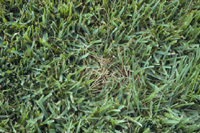
Initial symptoms of Pythium blight in tall fescue (Courtesy L.L. Burpee)
Symptoms and signs
Symptoms
Symptoms of Pythium blight are evident during warm, humid weather when turfgrass leaves are wet for at least 12 hours. The disease is particularly severe when daytime temperatures exceed 28°C (82°F) and night temperatures fail to fall below 20°C (68°F). Initial symptoms appear as dark green to purple water-soaked leaves that aggregate into circular or irregularly shaped patches in turfgrass swards (Figures 1-9). These patches can range in size from < 1 to > 20 cm (0.4 to > 8 in.) in diameter. No distinct lesions are formed on infected leaves, which often feel slimy or greasy when rubbed between two fingers. Patches of infected grass can enlarge and coalesce, causing severe damage to lawns, golf courses and athletic field turf (Figures 10-11). Pythium blight can also appear as streaks in areas where the fungal-like pathogen is spread by flowing water or mowing equipment (Figure 12). In addition to foliar blight, crown, stolon and root rot are frequently associated with Pythium blight.

Figure 1 |
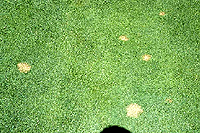
Figure 2 |
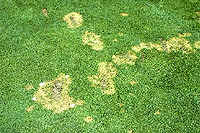
Figure 3 |

Figure 4 |

Figure 5 |

Figure 6 |
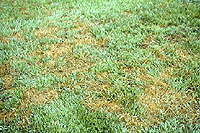
Figure 7 |

Figure 8 |
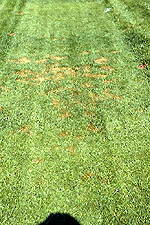
Figure 9 |

Figure 10 |

Figure 11 |

Figure 12 |
Signs
Pythium blight is also called "cottony blight" which refers to the cotton candy-like growth of white, fluffy aerial mycelium growing from infected turfgrass foliage (Figures 13-15). The mycelium is most abundant when infected leaves are wet, e.g. in the morning after a night of rain or heavy dew. Aerial mycelium produced by Pythium spp. is similar in appearance to mycelium produced by Sclerotinia homoeocarpa, which causes dollar spot and Rhizoctonia solani, the causal agent of brown patch. However, the latter pathogens produce foliar symptoms that are distinct from those produced by Pythium spp. Even though the aerial mycelium of the three pathogens is similar in appearance, microscopic observation of the hyphae reveals major differences. The most notable difference is the absence of septa in hyphae of Pythium spp. (Figure 16A), whereas Rhizoctonia and Sclerotinia spp. are septate. In addition Rhizoctonia produces hyphae that branch at right and acute angles to the main hypha (Figure 16B). The branch hyphae appear slightly constricted at their origin, and a septum is present near the branch origin. Right-angled branching is also a characteristic that distinguishes R. solani from S. homoeocarpa (Figure 16B and C). The diameter of S. homoeocarpa hyphae is generally larger than R. solani hyphae.
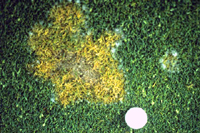
Figure 13 |
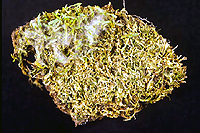
Figure 14 |

Figure 15 |
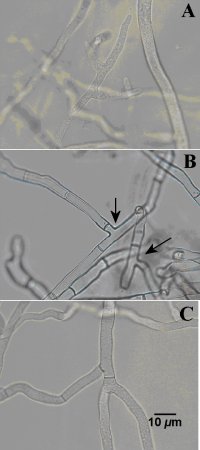
Figure 16 |
Pathogen Biology
Members of the genus Pythium belong to a group of organisms known as “oomycetes.” Although appearing similar to fungi, Pythium spp. and other oomycete pathogens behave quite differently from fungi and often require distinct methods of management.
Pythium aphanidermatum is the primary species associated with Pythium blight in the US, however, as many as 15 other species of Pythium have been associated with foliar blight symptoms. The relative abundance of P. aphanidermatum and other Pythium species from samples submitted to plant disease diagnostic clinics is not readily known. For the most part, when submitted disease samples are diagnosed as Pythium blight, the species of Pythium is not normally identified and reported.
Asexual reproduction. Pythium spp. produce sack-like structures called sporangia, which vary in shape from filamentous to spherical. Pythium aphanidermatum and many other turfgrass-associated Pythium form lobed sporangia (Figure 17) while other Pythium species may form spherical sporangia (Figure 18). When mature, a sporangium can germinate to produce a hypha or give rise to zoospores. Zoospores are asexual, motile spores thatare formed in a vesicle and released when the vesicle wall ruptures. Zoospores use flagella to "swim" in free water in soil or on plant surfaces (see disease cycle). Once in contact with plant tissue, zoospores encyst, and then the cyst germinates to form a hyphal germ tube that infects host tissues. In addition to sporangia and zoospores, mycelium serves as inoculum by growing through the foliar canopy of turfgrasses and penetrating leaves directly.

Figure 17 |

Figure 18 |
Sexual reproduction. In addition to asexual reproduction, most Pythium spp. reproduce sexually. Sexual reproductive structures include an oogonium and a club-shaped antheridium (see disease cycle). The two structures can form from a common strand of hyphae, or form two different hyphal strands. When the two structures come in contact, a fertilization tube enters the oogonium from the antheridium, and the antheridial nucleus is transferred to the egg within the oogonium (Figure 19). The antheridial and oogonial nuclei unite and form a zygote. The wall of the egg cell then thickens creating an oospore which contains the zygote. The oospore (Figures 20-21) can survive periods of drying and remain viable for many years.
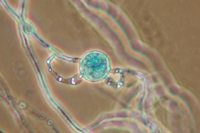
Figure 19 |
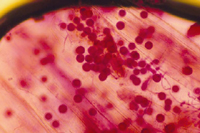
Figure 20 |
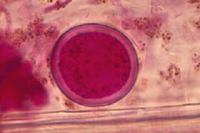
Figure 21 |
Disease Cycle and Epidemiology

Pythium aphanidermatum and other Pythium species survive largely as oospores in turfgrass root zones and thatch, but also as vegetative mycelium in turfgrass leaves and roots. When conditions are not conducive for disease development, survival as sporangia, zoospores and mycelium is considered to be short-lived. Under favorable conditions for disease development, mycelium can resume growth and infect a grass plant in 1-2 hours. Infection of turfgrass leaves occurs by direct penetration from vegetative hyphae or zoospores. Zoospores require free water to move and infect other turfgrass plants. Pythium species can also spread to other adjacent susceptible grass plants by mycelial growth. Infested material in the form of soil and thatch can spread the pathogen when transported to other areas. Movement of Pythium propagules can also occur on infested mower clippings, as well as dispersal of zoospores on equipment when conditions are wet.
Epidemiology
Pythium blight can occur during periods of cool (13 - 18°C / 55 - 64°F), wet weather, but the disease is most severe during periods of hot (30-35°C / 86 - 95°F), humid, rainy or cloudy weather. Pythium aphanidermatum, in particular, is most virulent when temperatures are between 30° and 35°C (86 - 95°F) and nighttime temperatures remain above 21°C (70°F). The highest frequency of foliar infection occurs during periods of high relative humidity (>90%) and prolonged leaf wetness. However, root and crown infections by P. aphanidermatum and other “foliar blighting” Pythium species can also occur, which maintains pathogen populations when conditions are less favorable for disease development.
The susceptibility of some turfgrasses to Pythium sp. can be enhanced by specific environmental factors. For example, high soil salinity predisposes creeping bentgrass to infection by P. aphanidermatum. Soil salinity is normally a problem in arid environments where salt levels fluctuate throughout the year based on water quality and the frequency and duration of irrigation events. During periods of high salinity, Pythium blight can occur at air temperatures and atmospheric humidities that are lower than those normally thought to be favorable for disease development. In addition to soil salinity, drought stress may enhance turfgrass susceptibility to Pythium infection. For example, creeping bentgrass is more susceptible to attack from some Pythium species when grown at low soil moisture (-1.5 MPa) than at field capacity (-0.033 MPa). Other local site factors that favor the development of standing water also enhances the spread of Pythium spp. Fertility can also have an impact on Pythium blight. High levels of nitrogen fertilization enhance the severity of Pythium blight by creating a lush turf canopy. Variations in calcium nutrition, particularly a calcium deficiency, can predispose plants to Pythium blight.
Disease Management
Cultural management
Cultural practices can be used to promote an environment where infection by Pythium species is limited. Irrigation is an important cultural practice to monitor. Watering early in the day will allow grass blades to dry and thus decrease the probability of leaves remaining wet overnight. Irrigation also has an impact on the relative humidity within the foliar canopy of turfgrasses. This is the major reason that late afternoon and evening watering should be avoided on warm days. Providing good surface and subsurface drainage when establishing new turfgrass sites, and renovating areas where water can pool in established turfgrass areas are other important steps in Pythium blight management. Other important management practices include removing thatch to improve drainage, reducing drought and nutrient stresses on turf, and removing sources of Pythium inoculum. Thatch should be removed if it is greater than 0.6-1.2 cm (0.25-0.5 in.) in depth, depending on height of cut. Thatch is removed by vertical mowing and topdressing with sand or soil. A balanced system of turfgrass nutrition is also a key to controlling Pythium blight. Excessive fertilization during hot months, particularly nitrogen applications, can exacerbate disease severity. Levels of nitrogen applied to turf should be monitored, and it is recommended that monthly applications be less than 25 kg of nitrogen per ha (0.5 pounds of nitrogen per 1,000 square feet) during periods of hot weather. When applying nitrogen-based fertilizers, it is best to use slow-release sources or to "spoon-feed" turf with light foliar applications of fertilizer during spring or summer when occurrence of Pythium blight is most likely. It is also important to avoid calcium deficiency and to maintain a slightly acidic soil pH. Promoting good airflow across golf greens and other areas of turf by pruning trees and shrubs will promote light penetration and increase air movement that facilitates drying of the turfgrass foliage. When mowing, avoid areas of wet turf when the temperature is > 21°C (70°F) and washing mowing equipment before entering unaffected areas; these practices will help minimize the spread of the pathogen. Also, alleviate soil compaction in order to improve turfgrass root growth. When over seeding with cool-season turfgrass species, delay the process until late summer or early fall when the nighttime temperatures have cooled to < 18°C (65°F).
Chemical management
Fungicides in the following classes are effective for the control of Pythium blight: aromatic hydrocarbons, carbamates, dithiocarbamates, phenylamides, phosphonates, quinone outside inhibitors (QoIs, including the strobilurins), as well as quinone inside inhibitors (Qils, which includes cyano-imidazoles). The repeated use of some Pythium fungicides, particularly metalaxyl or mefenoxam (phenylamides), may select for resistant populations of P. aphanidermatum. Fungicides from different chemical groups should be alternated or combined in a control program to limit development of resistant populations of Pythium spp. Alternating between systemic and contact fungicides may delay resistance development. Fungicide-treated seed is available for turfgrass establishment or for overseeding dormant warm-season grasses.
Forecasting the times of highest disease risk should be a component of any preventative fungicide program and instituting a disease-monitoring system can limit losses caused by Pythium blight. Pythium blight has been forecast by monitoring air temperature and relative humidity (RH). The Nutter-Shane model predicts high disease risk when the maximum air temperature is > 30° (86°F), and RH is > 90% for a 14-hour period during which time the ambient temperature remains > 20°C (68°F). As a general rule, if average nighttime temperature plus average relative humidity equal 150, then the risk for Pythium blight is high. However, some researchers state that this model might over-predict the risk for Pythium blight, forecasting disease occurrence when it subsequently does not develop.
Biological control
Attempts have been made to use bacteria (e.g. Enterobacter cloacae and Pseudomonas spp.) and fungi (e.g. Trichoderma hamatum and other Trichoderma spp.) to suppress Pythium species causing Pythium blight. There are currently several commercial biological control materials labeled for Pythium blight control including: Companion (Bacillus subtilis strain GB03), Double Nickel LC (Bacillus amyloliquefaciens strain D747), TurfMate (Trichoderma harzianum),Turfshield (Trichoderma harzianum Rifai strainT22 + Trichoderma viride strain G41), and Regalia (plant extract of Reynoutria sachalinensis).
Resistant species and cultivars
In general, warm-season turfgrass species are less susceptible to P. aphanidermatum and other Pythium species than are cool-season grasses. Among cool-season grasses, annual bluegrass, perennial ryegrass and tall fescue are highly susceptible whereas the fine-leaf fescues and Kentucky bluegrasses are less susceptible. Creeping bentgrass varieties may vary in their susceptibility to P. aphanidermatum and other Pythium species. A few cultivars of Kentucky bluegrass, perennial ryegrass and tall fescue have exhibited moderate resistance to P. aphanidermatum. Cool-season grasses, used for winter overseeding of hybrid bermudagrasses, are highly susceptible to Pythium spp. Most of the improved cultivars of bermudagrass are not highly susceptible to Pythium species. Consult local turfgrass extension personnel for information on disease resistance for your area. Information on the level of susceptibility of specific turfgrass species can also be obtained from the National Turfgrass Evaluation Program (www.ntep.org), however, data on susceptibility to Pythium blight is limited.
Significance
Historical significance
Pythium blight, also referred to as "spot blight", "grease spot", or "cottony blight", was first reported in the 1930s, but the disease was not recognized as a problem in some parts of the U.S. until 1954. Pythium blight was initially thought to be a disease of only golf course turf, however, the disease is now recognized as a problem on lawns and athletic fields as well. The disease has been detected on warm- and cool-season turfgrass species all over the world.
The first fungicides used for the control of Pythium diseases included inorganic mercury, captan, dichlone, cycloheximide, and organic mercury compounds. These chemicals only provided limited control of Pythium blight. In 1979, metalaxyl was the first systemic fungicide registered in the U.S for the specific purpose of controlling diseases caused by Pythium, Phytophthora spp., and downy mildew pathogens (oomycetes). This included the specific use for controlling Pythium blight on turfgrasses. In 1983, metalaxyl-resistant populations of P. aphanidermatum were detected in creeping bentgrass samples in Pennsylvania. The samples were from golf courses that had used metalaxyl extensively to control Pythium blight over a period of three years. More recently, isolates of P. ultimum from greenhouse-grown ornamentals and turfgrass plants have been found to exhibit resistance to mefenoxam (another fungicide in the same chemical group) in laboratory assays.
Additional Reading
Abad, Z. G., H. D. Shew, and L. T. Lucas. 1994. Characterization and pathogenicity of Pythium species isolated from turfgrass with symptoms of root and crown rot in North Carolina. Phytopathology 84:913-921.
Dernoeden, P. H. 2013. Understanding modern turf fungicides. Pages 217-249. In: Creeping Bentgrass Management, 2nd Edition. CRC Press-Taylor & Francis Group.
Kerns, J. P. and L. P. Tredway. 2008. Pathogenicity of Pythium species associated with Pythium root dysfunction of creeping bentgrass and their impact on root growth and survival. Plant Dis. 92:862-869.
Nelson, E. B. and C. M. Craft. 2000. Microbial strategies for the biological control of turfgrass diseases. Pages 342-352 in J. M. Clark and M. P. Kenna, editors. Fate and Management of Turfgrass Chemicals. American Chemical Society, Washington, DC.
Nutter, F.W., H. Cole, Jr., and R.D. Schein. 1983. Disease forecasting system for warm weather Pythium blight of turfgrass. Plant Dis. 67:1126-1128.
Saladini, J. L., A. F. Schmitthenner, and P. O. Larsen. 1983. Prevalence of Pythium species associated with cottony-blighted and healthy turfgrasses in Ohio. Plant Dis. 67:517-519.
Smiley, R.W, P.H. Dernoeden, and B.B. Clarke. 2005. Compendium of Turfgrass Diseases 3rd ed. American Phytopathological Society, St. Paul, MN.
Smith, J.D, N. Jackson, and A.R. Woolhouse. 1989. Fungal Diseases of Amenity Turf Grasses. E. & F.N. Spon, Ltd. New York, NY.
